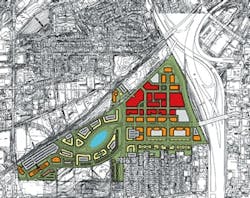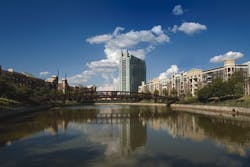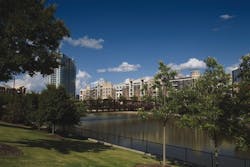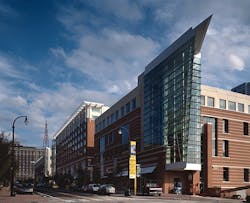The Return to Urban America
Perhaps Dorothy said it best in The Wizard of Oz when she proclaimed, "There's no place like home." But, the definition of home is relative. Today, the physical location of residences is what appears to be changing the most. Many once dreamed of a house in the suburbs with plenty of room to grow, but people are now choosing a condo in the city instead. Economic, environmental, and simple lifestyle changes are influencing today's definition of the American dream.
The factors influencing this change are similar to those in the past. Their sources are the same - government policies, transportation, and societal changes - but the outcomes are altogether different. Instead of commuting to work across long distances, people prefer to live closer to work, commute less, and spend more time enjoying the homes and lifestyles they've acquired.
Economic and environmental factors are playing a large role in the shift as well. The high price of oil is starting to influence people's opinions of long commutes and large cars. The pinch on pocketbooks is being felt across the country at press time, as oil prices settle in at record highs. The environmental impact of emissions caused by gas-guzzling vehicles is also playing a part. Adults are slowly starting to think more environmentally, but the younger generation is having the biggest impact on our opinions. All in all, there's a shift in priorities and desires on the horizon, and a shift in the U.S. population, which is headed back to downtown America.
The master plan for Atlantic Station, one of America's most notable mixed-use developments, was created in the mid-1990s. The community continues to flourish, but based on current lifestyle and environmental elements, it would probably be developed differently today.
In the mid-1990s, a master plan was created for Atlanta's newest - and one of the nation's most notable - mixed-use developments: Atlantic Station®. Described by a New York Times writer as "exhibit A" of mixed-use development, Atlantic Station was the quintessential live-work-play community when it was planned more than 10 years ago. Located just west of Midtown Atlanta, featuring high-rise office space, hotels, retail, and numerous types of housing, the community has blossomed into one of the busiest, most popular destinations in the city. At the time it was planned, pushing the envelope of mixed-use design meant something that has understandably changed since. Simply reusing land for a new purpose - offering a pedestrian atmosphere and providing modest transit options - may no longer be enough for the new urban dweller; yet, at the time, it was groundbreaking. Today, the community continues to flourish. But, would it be developed the same today? Probably not. Instead, we would need to take a closer look and plan for larger lifestyle and environmental elements.
Today's mixed-use centers need to focus on links to the larger urban core and nearby neighborhoods. Transit needs to be a major component of mixed-use plans, in addition to neighborhood-focused offerings, such as dry cleaners, cafés, and grocery stores, all located within a few-block radius. The U.S. Green Building Council's (USGBC) LEED-ND program is a good place to start. According to the USGBC, LEED-ND integrates the principles of smart growth, urbanism, and green building into the first national system for neighborhood design. The program is designed to reduce urban sprawl, encourage healthy living, protect threatened species, increase transportation choices, and decrease automobile dependence. LEED-ND certainly provides a strong foundation for the planning of new mixed-use communities. To be truly successful and innovative in the development of new planned communities, however, we must push the envelope even further beyond what's expected.
In 2006, a 30-year expansion plan was created for the University of Pennsylvania. The 42-acre, $6 billion expansion aims to reconnect the school with Philadelphia's Center City while revitalizing land along the Schuylkill River. The plan intends to transform an industrial corridor while meeting the school's expansion needs and melding the campus with the western portion of the city. The main driver behind the plan is the University of Pennsylvania's acquisition of a set of properties vacated by the U.S. Postal Service. Recommended uses for the site call for a mix of research spaces, offices, and housing; shops and restaurants; and athletic fields, parks, and public and cultural spaces. In the broader scheme of things, the plan is a critical example of how universities play a vital role in the overall redevelopment and revitalization of our nation's cities.
Take, for example, the Technology Square project in Midtown Atlanta. The development sits just across the 75/85 Interstate Connector that runs through downtown Atlanta and separates the Georgia Institute of Technology from the city center. The development reaches into the midtown business district across this connector from the traditional Georgia Tech campus, establishing a new gateway for the campus. The $122 million, 5-building complex has transformed the 3-block site from surface parking lots into a new, dynamic, urban community. Brightly painted courtyards and generous use of fenestration symbolize openness and a sense of time and place, which logically knit together the College of Management, the Global Learning Center, the Hotel & Conference Center, the Barnes & Noble @ Georgia Tech Bookstore, and various retail outlets and offices anchored by the Economic Development Building. The development is linked to the Georgia Tech campus by a wide bridge that features generous sidewalks for ample foot traffic. The site is also close to Atlanta's mass-transit system (MARTA), allowing students, workers, and visitors to easily access the site. Due to the collaboration of the designers, the owner, and the numerous users in meeting the needs and aspirations for this project, Technology Square is a giant leap forward in the university's long-standing mission of reaching out to the community. Today, the project is flourishing, and it has prompted even further progress as other developers look to transform areas adjacent to Technology Square.
Perhaps one of the most notable factors fueling the trend toward redevelopment of urban sites is the realization that more makes the city better, while less of everything is better in suburbia. Developers are realizing that it's easier to get economically sustainable, mixed-use projects approved in existing cities than in automobile-oriented suburbs. More restaurants, shops, residents, and jobs make urban environments more dynamic and attractive. More importantly, density increases the viability of mass-transportation systems and innovative transportation models, such as car sharing - all of which reduce dependency on personal automobiles for daily needs.
Moving forward, the most important factor in the design of mixed-use developments will be the extent to which the resultant environment supports walking, bicycling, and mass transit as viable choices for travel within a 100-mile radius of home. The question you should be asking every time a new mixed-use project is evaluated is this: "Can the people who live and work here sustain their lifestyles for travel between home, work, and leisure destinations within 100 to 500 miles either by walking, biking, taking the bus or train, or using a shared car?" Most large American cities provide this opportunity through pre-existing urban patterns and transportation infrastructure; however, while a city-like pattern of development can be replicated in the suburbs and in greenfield sites, construction of new mass-transportation infrastructure is expensive and cannot be afforded by most privately financed mixed-use development projects.
It has been said that the three most important factors in determining the desirability of a property are "location, location, location." It appears today that the "city" may well become the most preferred location for America's big mixed-use development projects.
Anish Kumar is managing principal of planning and urban design at Thompson, Ventulett, Stainback and Associates (TVS) in Atlanta.




